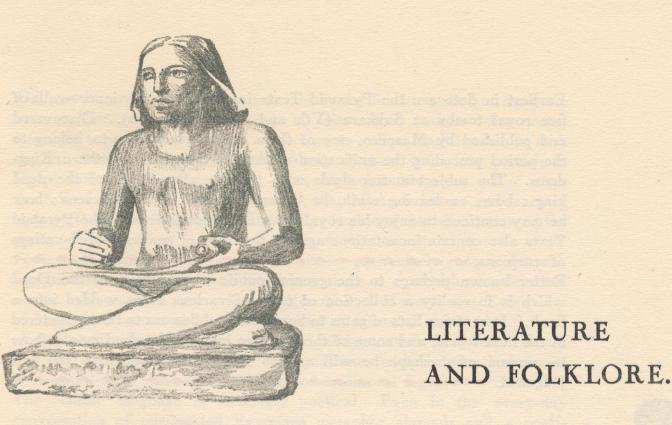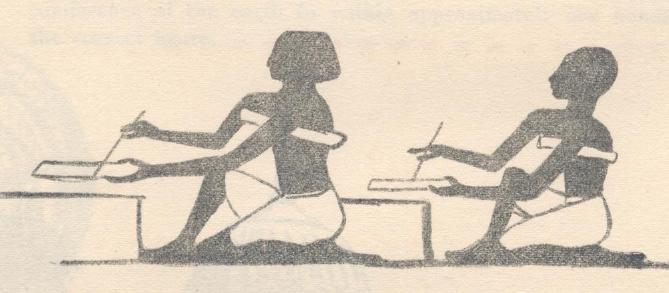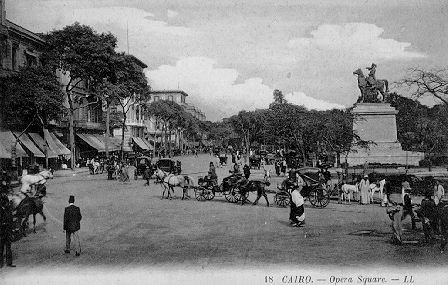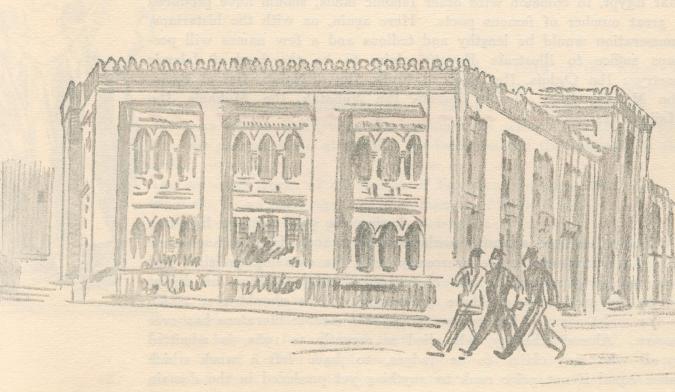
"Were does folklore end and literature begin? Do they, must they merge one into the other or may they grow side by side? In Egypt, as in other countries, it is probable that the earliest literature embodied much of the lore, the "oft-told tales" which, handed down by word of mouth, had charmed previous generations. Many Egyptian tales have come down to us. Some of them are what modern
parlance would call fairy tales and they usually point a distinct moral.
Such for instance (dating back to the Middle Kingdom) is the story of the
Two Brothers with its picture of the industrious farmer, the story of the
Predestined Prince, the story of the Eloquent Peasant whose ass had been
stolen and the tale of the Shipwrecked Sailor in the Red Sea. The latter,
with its marvellous adventures, suggests comparison with the much later
story of Sinbad the Sailor.
Of these stories it is probable that they were not so much new compositions as the recording of a legend already well known. But a vast amount of other writing has come down to us from the ancient Egyptians. It comprises documents of almost every conceivable kind: business documents and correspondence, legal documents, memorial inscriptions, historical, scientific, magical and religious literature as well as tales and lyrics in poetical language. Earliest in date are the Pyramid Texts inscribed on the inner walls of five royal tombs at Sakkara (Vth and VIth Dynasties). Discovered and published by Maspero, one of them at least is known to belong to the period preceding the unification of the Northern and Southern Kingdoms. The subject matter deals with the life after death of the dead king : how, on leaving earth, he becomes a star in the heavens; how he may continue to enjoy his royal titles and prerogatives. The Pyramid Texts also contain incantations against the bites of snakes and the stings of scorpions. Better known perhaps to the general public is the Book of the Dead which is in reality a collection of texts of various dates welded into a book. It contains lists of gates to be passed and demons to be encountered in the next world, and some of the chapters instruct the dead man in how to assume what shape he will and to issue triumphant from the last judgment.  The standard works of all classes of Egyptian literature date back, in the main, to an early age, not later than the Middle Kingdom. At that period several books of proverbs or instructions were put in circulation; some of them, forestalling the. Chesterfield letters, deal with manners and deportment; in one, King Amenemhe lays down for the guidance of his son the principles of kingship and government. In yet another, Kheti, a scribe, extols the advantages of his profession and describes e drawbacks of all other avocations. It must however be admitted that, apart from their historical interest,
the book of Ancient Egypt are not transcendant from purely
 Poetry and history were -and still are -particularly congenial to the Egyptian man of letters. Of historians there is a wealth of celebrated To mention but a few: Ibn Abd el Hakam, Ibn Zulaq, Izz al Mulk Mohammed al Musabbihi, J amal al Din al Halabi, Abd al Latif al Baghdadi, Tha'lab Kamal al Din al Edfawi, Makrizi Abul Mahasin and Abd ar Rahman al J abarti. Acquaintance with the two last-named is essential to a thorough knowledge of mediaeval Egypt. The Arabic language is strikingly poetical. Even in the every-day conversation of uneducated Egyptians metaphor abounds and a poetical trend of thought is very apparent. It is therefore not surprising that Egypt, in common with other Islamic lands, should have produced a great number of famous poets. Here again, as with the historians, enumeration would be lengthy and tedious and a few names will perhaps suffice to illustrate Egypt's claim to be the land of Islamic poetry: Ibn Qalqis, Ibn.Sana al Mulk, Ibn al Nabih, Ibn al Farid, Ibn Matruh, Baha al Din Zukmr, Ibn Nubatah, Ibn Mukams, Ibn Hajja al Hamawi. During the past century Egyptian letters have enjoyed a most 'remarkable
renaissance, It is perhaps more than a coincidence that, concurrently with
the amazing political and economic progress which has characterized the
evolution of Egypt during the past two or three generations, there should
have arisen; in her midst some of the greatest poets that Arabic literature
has ever known. Ahmed Chawky, who died as recently as 1932, is admitted
by all who may claim to be judges, to have left a work which takes equal
if not prior rank to anything yet produced in the domain of Arabic poetry.
|

